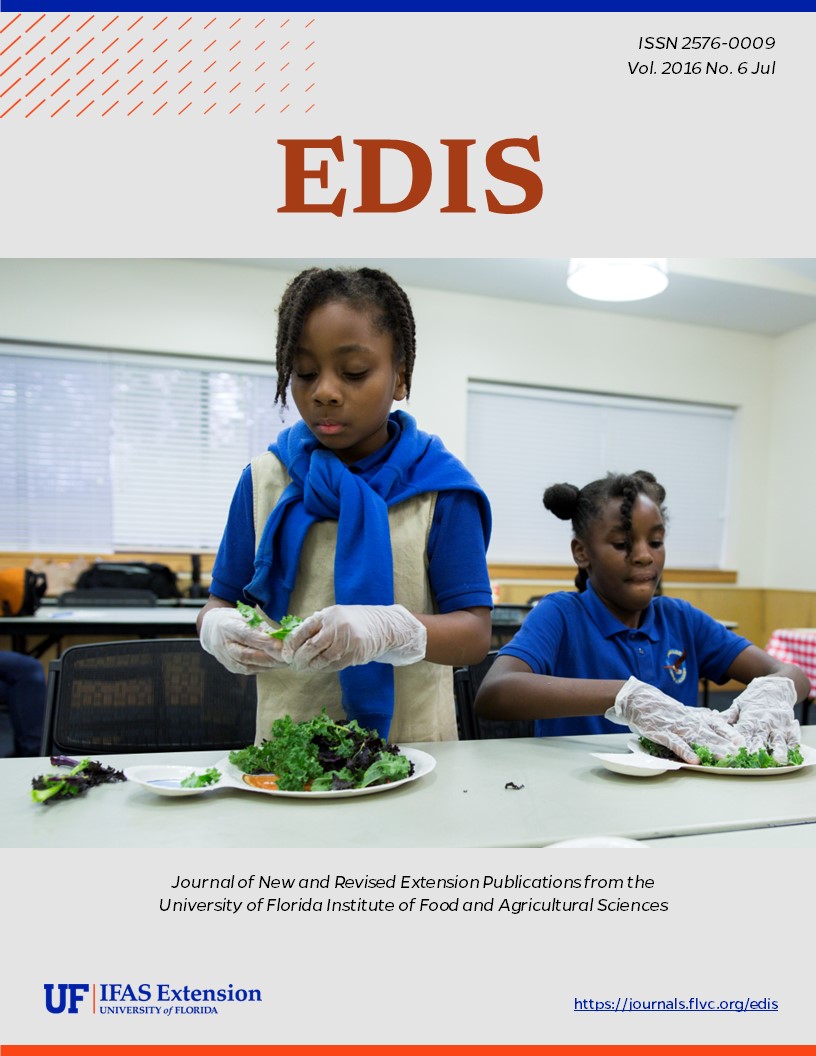Abstract
This EDIS publication is an alternate version of a page published first on the Featured Creatures website. The Featured Creatures collection provides in-depth profiles of insects, nematodes, arachnids and other organisms relevant to Florida. These profiles are intended for the use of interested laypersons with some knowledge of biology as well as academic audiences. This 6-page fact sheet that discusses the melaleuca gall midge was written by Matthew R. Moore, James P. Cuda, Paul D. Pratt, and Min B. Rayamajhi, and published by the UF Entomology and Nematology Department, July 2016.
References
Balciunas JK, Burrows DW, Purcell MF. 1994. Field and laboratory host ranges of the Australian weevil Oxyops vitiosa (Coleoptera: Curculionidae), a potential biological control agent for the paperbark tree, Melaleuca quinquenervia. Biological Control 4: 351-360. (30 September 2019) https://doi.org/10.1006/bcon.1994.1044
Bodle MJ, Ferriter AP, Thayer DD. 1994. The biology, distribution, and ecological consequences of Melaleuca quinquenervia in the Everglades. p. 341-355. In Davis SM and Ogden JC (eds.), Everglades: The ecosystem and its restoration. St. Lucie Press. Delray Beach, Florida, United States. 860 p.
Center TD, Van TK, Rayachhetry M, Buckingham GR, Dray Jr. FA, Wineriter SA, Purcell MF, Pratt PD. 2000. Field colonization of the Melaleuca Snout Beetle (Oxyops vitiosa) in South Florida. Biological Control 19: 112-123. (30 September 2019) https://doi.org/10.1006/bcon.2000.0856
Center TD, Pratt PD, Tipping PW, Rayamajhi MB, Van TK, Wineriter SA, Dray Jr. FA, Purcell MF. 2006. Field colonization, population growth, and dispersal of Boreioglycaspis melalucae Moore, a biological agent of the invasive tree Melaleuca quinquenervia (Cav.) Blake. Biological Control 39: 363-374. (30 September 2019)
Center TD, Pratt PD, Tipping PW, Rayamajhi, Wineriter SA, Purcell MF. 2008. Biological control of Melaleuca quinquenervia: Goal-based assessment of success. p. 657-666. In Julien M, Sforza R, Bon MC, Evans HC, Hatcher PE, Rector BG (eds.), Proceedings of the XII International Symposium on Biological Control of Weeds. CSIRO European Laboratory. Montpellier, France. 768 p. (30 September 2019)
Center TD, Purcell MF, Pratt PD, Rayamajhi MB, Tipping PW, Wright SA, Dray Jr. FA. 2012. Biological control of Melaleuca quinquenervia: an Everglades invader. BioControl 57: 151-165. (30 September 2019) https://doi.org/10.1007/s10526-011-9390-6
Craven LA, Lepschi BJ. 1999. Enumeration of the species and infraspecific taxa of Melaleuca (Myrtaceae) occurring in Australia and Tasmania. Australian Systematic Botany 12: 819-927. (30 September 2019) https://doi.org/10.1071/SB98019
Dray Jr. FA, Bennett BC, Center TD. 2006. Invasion history of Melaleuca quinquenervia (Cav.) S.T. Blake in Florida. Castanea 71: 210-225. (30 September 2019)
Gagné RJ. 2010. Update for a catalog of the Cecidomyiidae (Diptera) of the world. Systematic Entomology Laboratory, Agricultural Research Service, U. S. Department of Agriculture. Washington, D. C., United States. 544 p. (30 September 2019)
Gagné RJ, Balciunas JK, Burrows DW. 1997. Six new species of gall midges (Diptera: Cecidomyiidae) from Melaleuca (Myrtaceae) in Australia. Proceedings of the Entomological Society of Washington 99: 312-334. (30 September 2019)
Gagné RJ, Wright SA, Purcell MF, Brown BT, Pratt PD, Center TD. 2009. Description of the larva of Lophodiplosis trifida, an Australian gall midge (Diptera: Cecidomyiidae) and biocontrol agent of paperbark in Florida, USA. The Florida Entomologist 92: 593-597. (30 September 2019) https://doi.org/10.1653/024.092.0410
Goolsby J, Purcell M, Wright T, Makinson J, Zonneveld R, Brown B. 2002. 2002 Annual Report. Australian Biological Control Laboratory. United States Department of Agriculture. Agricultural Research Service. Office of International Research Programs. Australian Biological Control Laboratory. Indooroopilly, Queensland, Australia. 100 p. (30 September 2019)
Laroche FB. 1998. Managing melaleuca (Melaleuca quinquenervia) in the Everglades. Weed Technology 12: 726-732. (30 September 2019) https://doi.org/10.1017/S0890037X00044626
Nehrling H. 1933. The plant world in Florida; from the published manuscripts of Dr. Henry Nehrling; collected and edited by Alfred and Elizabeth Kay. MacMillan Co. New York, New York, United States. 304 p.
Pratt PD, Rayamajhi MB, Tipping PW, Center TD, Wright SA, Purcell M. 2013. Establishment, population increase, spread, and ecological host range of Lophodiplosis trifida (Diptera: Cecidomyiidae), a biological control agent of the invasive tree Melaleuca quinquenervia (Myrtales: Myrtaceae). Environmental Entomology 42: 925-935. (30 September 2019) https://doi.org/10.1603/EN13058
Pratt PD, Rayamajhi MB, Brown B, Purcell MF, Center TD. 2014. Within-plant distribution of the Melaleuca quinquenervia biological control agent Lophodiplosis trifida. Biocontrol Science and Technology 24: 1073-1076. (30 September 2019)
Purcell M, Wineriter S, Brown B. 2007. Lophodiplosis trifida Gagné (Diptera: Cecidomyiidae), a stem-galling midge with potential as a biological agent of Melaleuca quinquenervia (Myrtaceae). Australian Entomologist 34: 123-125.
Rodgers L, Black D, Bodle M, Laroche F. 2014. Chapter 7: Status of nonindigenous species. 2014 South Florida Environmental Report 1: 1-53. (30 September 2019)
Rodgers L. 2016. Chapter 7: Status of nonindigenous species. 2016 South Florida Environmental Report 1: 1-51. (30 September 2019)
Small JK. 1933. Manual of the southeastern flora: being descriptions of the seed plants growing naturally in Florida, Alabama, Mississippi, eastern Louisiana, Tennessee, North Carolina, South Carolina and Georgia. New York, New York, United States. 1554 pp. (30 September 2019) https://doi.org/10.5962/bhl.title.696
Tipping PW, Martin MR, Pratt PD, Center TD, Rayamajhi MB. 2008. Suppression of growth and reproduction of an exotic invasive tree by two introduced insects. Biological Control 44: 235-241. (30 September 2019) https://doi.org/10.1016/j.biocontrol.2007.08.011
Turner CE, Center TD, Burrows DW, Buckingham GR. 1998. Ecology and management of Melaleuca quinquenervia, an invader of wetlands in Florida, U. S. A. Wetlands Ecology and Management 5: 165-178. (30 September 2019)
United States Department of Agriculture (USDA). Animal and Plant Health Inspection Service (APHIS). 2008. Field release of the biological control agent Lophodiplosis trifida Gagné (Diptera: Cecidomyiidae) for the control of Melaleuca quinquenervia (Cav.) S.T. Blake (Myrtales: Myrtaceae) in the continental United States. Environmental Assessment April 15, 2008. 30 pp. (30 September 2019)
Wineriter Wright SA, Center RD. 2008. Nonselective oviposition by a fastidious insect: The laboratory host range of the melaleuca gall midge Lophodiplosis trifida (Diptera: Cecidomyiidae). Biocontrol Science and Technology 18: 793-807. (30 September 2019) https://doi.org/10.1080/09583150802344902

